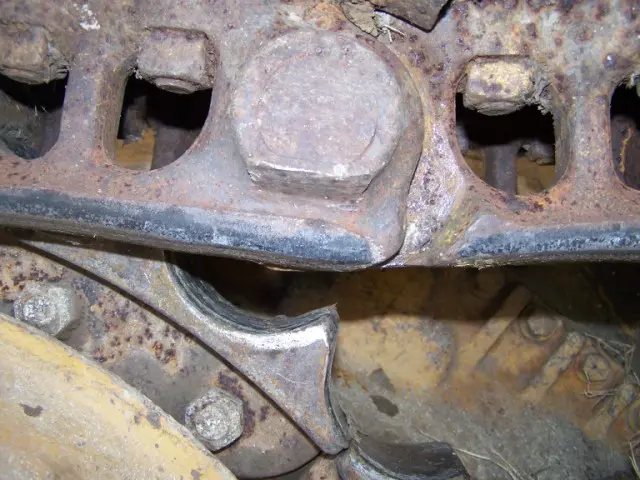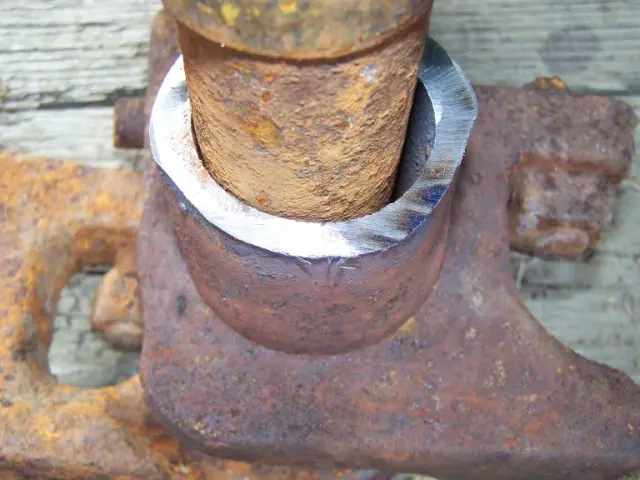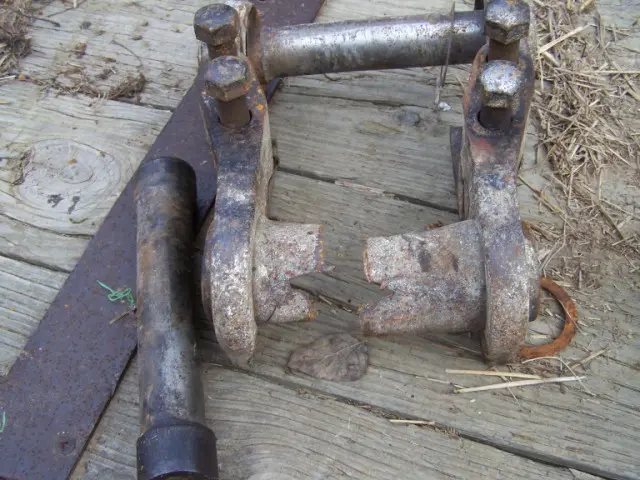CC Jersey
Well, that's my answer if the tracks aren't reversed. I've never seen it tried with reversed tracks.
We have cut out one link of the rail by cutting it between the bolt holes for the shoe so you end up removing one pin/bushing and half a link of rail on either side. Then the ends of the rail are pulled together, the shoe bolted on, and the ends of the rail welded together. This allows the track to be tightened with the idler adjustment enough that they will stay on and ran until the bushings are worn thru.
Do not replace the sprocket segments with new segments. Two bad things will happen. First, the segments will wear out fast and you waste that money and effort. Second, more of the weight of the machine is transferred to the sprocket because of the new segments and the rail and rollers being worn. And that is not good for the drives. And it makes for a noisy, crunchy ride when you are on firm ground.
Best regards,
Thomas
Aftermarket sprocket segments are $650. Watching the tracks run now, the sprocket pulls tight on one bushing or maybe two at the bottom (6 o-clock) and by 9 o-clock are very slack on the sprocket teeth. Also sprocket teeth are really pointed and getting short-ish. I was considering that the new segments would make the sprocket a little bigger diameter than it is now and help match the pitch even though that is worn badly. Not to mention the teeth would have some height and not so much of a ramp
Really the biggest reason I am considering running them backwards is to wear on a bushing surface that has some room to wear before it cracks away. Wear may be accelerated, but there is some meat there instead of the other side where we're close to going through.
Found a set of old tracks for scrap price, those are the ones that are 100% worn on height and length and well past needing to be turned, but never been turned. Tracks on dozer when we bought it have 1/8" more height (about 80% worn instead of 100%) and roller flanges are not quite cutting into the pin bosses yet, but one side is now through to the pins (yeah, I didn't look carefully at both sides before we picked it up:lol😊
This weekend swapped the worst track with bad bushings for one of the worn out used ones, not sure if they put on sprocket segments yet or not. When the "new" tracks were removed from the previous tractor, they cut a link, so since we needed to shorten them up anyway, we purchased a new master pin and spacers and just torched away the pieces of link as needed. Our old tracks had alligator master links in them, but they are just worn out, so no putting them back on without new bushings and pins.
I'll try to get some pictures and add here.




The sprocket segments were not installed yet. The sprocket on that side is better than the other one with the track that hasn't broken through the bushings.
Both tracks have been shortened a link now. Plenty of room to tighten them both.
First picture is "new" track and sprocket
Second is remaining old track and sprocket
Third is a section of the link we removed from "new track" bushing isn't much thicker on back side than front, so running tracks backwards wouldn't help much.
Fourth is the master link on the track that was replaced.
It's not worth spending one cent on trying to extend the life of those chains, it will cost you far more in the long run than just keeping going until they won't go round any more then replace chains and sprockets. Turning the tracks round will make them wear faster, new sprockets will wear so quickly that the 'extra' life will cost you more than you gain in the tracks.
Got a problem here.........
Rubbed the track links with pencil and paper, got numbers off them (2S1749/2S1750) and called CAT dealer parts to order a master bushing (one track has a cracked master) and 2 master pins. Said the numbers were no good, so supposedly looked up a D7E with our serial number and sent 2x pins 8E4273. These are too small to fit either the regular links of the "new" tracks we got the numbers from or the master link out of the destroyed track. Search engine results in "track pin 345 excavator"😞
I don't still have the box for the bushing, so not sure of the number they sent, but we pressed it into the old alligator style master link. Seems to fit properly as far as diameter goes. It has a slight shoulder on each end and if you press it to the shoulder, the bushing protrudes from the rails like a standard bushing should, however, that makes the link too narrow. So we moved the rails back out so the end of the bushing is flush like we needed it anyway and that puts the width where it can connect with it's matching master link half and the pad will fit on it.
When I put the part numbers off the master link into a search engine, (2P9653,54,55,56)I get returns listed as "master link D7G" When I put in the link numbers off the "new" tracks, it says D7F track link. The same search engine will take the parts numbers from my book for the D7E and comes back with D7E track link etc.
Are the 2S1749/2S1750 links different from the original D7E tracks
2S1749/2S1750 is one of the original 48A link options.
Uses reg pin 1M8958, reg bush 1M3669
mstr bush 1M3670, mstr pin 1m8957
No alligator link for this arrangement.
To use the 2P9653,4,5,6 alligator links requires reg links 8S2589/90 and uses the same regular pins and bushings as the 2S1749/50.
Doesn't really apply to the junk your working with but the original rail heights were 4.75" on the 2Sxxxx and 4.94" on the 8Sxxxx.